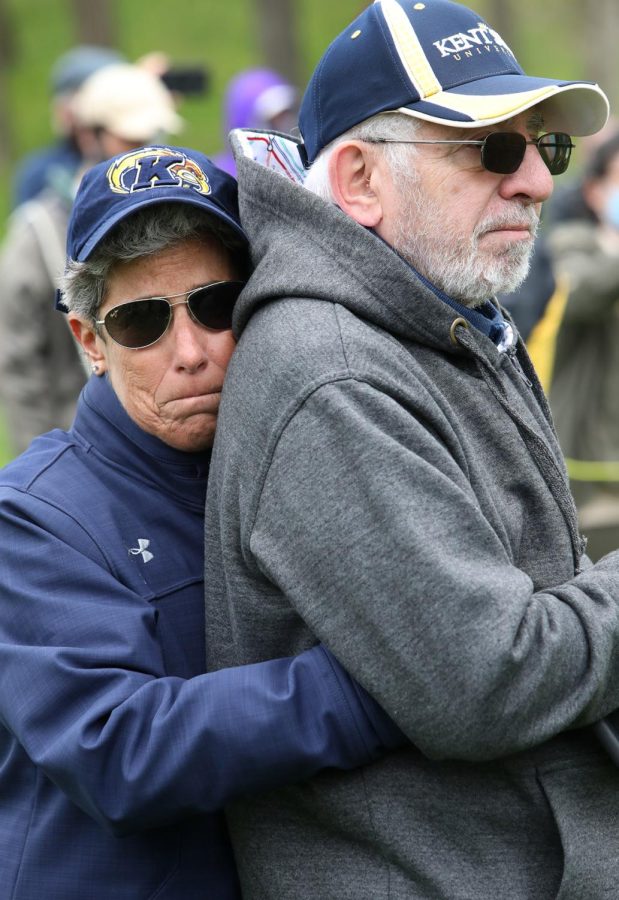Community gathers to commemorate 50th anniversary of May 4 shootings
May 4, 2020
Jerry Lewis, a professor whose name is synonymous with the May 4, 1970, shootings where four Kent State students lost their lives, rang the Victory Bell on the Commons below Taylor Hall in their honor today, 50 years after they were shot down by Ohio National Guardsmen during anti-war protests on campus.
The four students who died were Jeffrey Miller, Allison Krause, William “Bill” Schroeder and Sandra Scheuer. Nine others were wounded—Lewis also acknowledged the two students killed May 14, 1970, at Jackson State.
About 100 other community members, faculty and loved ones gathered in the Prentice Hall parking lot where the victims fell. Hal Yaeger was a friend of Krause’s in high school, and this was his first time coming to the May 4 commemoration.
“I still have pictures of [Allison] on my front lawn, she broke her arm because I was chasing her,” Yaeger said. “[I wanted] to commemorate the other three students, who were shot and killed, and obviously the others who were injured.”
Yaeger also said that Krause and the rest of the deceased never received a real resolution, according to her father, Arthur Krause.
“It’s something that’s never been fully resolved, how they were shot and killed for no reason,” Yaeger said. “Allison wasn’t doing anything, it’s just a horrible situation that was never really resolved to the satisfaction, certainly I know, of Arthur Krause. But also, I’m sure of the parents of the others who were shot or hurt.”
Maria Pokrandt was a senior at Kent during the events of May 4, 1970. She got on a plane to Spain to finish her undergraduate degree in foreign language and hadn’t returned until the 50th commemoration.
“[It was] a little chaotic, I stayed home because there was trouble brewing downtown and I watched it on the news,” Pokrandt said. “It was chaotic that day and confusing, and after that I was sad, angry [and] really confused. I wasn’t caught up much with the protesting because I’m academically oriented and I went to class—I was in class when the shooting took place.”
Colt Hutchison, president of Students for a Democratic Society (SDS), said he couldn’t imagine being anywhere else on this day.
“I can’t imagine not coming out,” Hutchison said, “I come every year but it’s the 50th, I feel like we have to pay our remembrance.”
Hutchison said that the events of May 4 tie into his role with SDS to serve as a constant reminder of American violence and unrest.
“I think it’s a reminder of America’s state of being a violent institution,” Hutchison said. “Any kind of organizing or activities can lead to the state calling in violence.”
Harold Greenberg was a student during the May 4 shooting who had just gotten out of class. He remembers hiding near Taylor Hall when he saw the presence of the Ohio National Guard.
“Once I saw that the guard was advancing, I stayed near [Taylor Hall],” Greenberg said. “Once I saw the students being rifled at, I went into the building. I ran around trying to find a place to hide in the building if the guard came in with mace.”
A yellow rope perimeter was set up around the Victory Bell to keep spectators from gathering too closely during the commemoration.
Once the rope was taken down, Bill Arthrell, who witnessed the shootings as a student at Kent State, spoke to the dispersing crowd for a few minutes, then dug a small hole in front of the Victory Bell and buried a copy of the U.S. Constitution.
The action was similar to one taken May 1, 1970, when members of the student group World Historians Opposed to Racism and Exploitation also buried the Constitution to symbolize what they called President Richard Nixon’s “murder” of constitutional principles when he ordered the invasion of Cambodia without a formal declaration of war from Congress.
“It’s really beautiful that all of these people have come out despite the coronavirus,” Hutchison said. “All of these people have been in these [parking] spots all night just to make sure that the lights are still held, it’s really beautiful.”
Contact Kaitlyn Finchler at [email protected].

















